At last the wraps have come off the production version of the Porsche 918 Spyder. The petrol electric hybrid sportscar has had a long gestation, first gracing the floor of the Geneva Motor Show in early 2010. It then trasnformed into the 918 RSR for the Detroit Auto Show in 2011, with the order book for the 918 Spyder officially opening in March of that year.
And now, at last, the real deal is here. In all of its 652kW glory. It tips the scales at 1634kg and with a 7-speed PDK and will see off 100km/h in 2.8 seconds. The double ton is gone in 7.7 seconds and the triple in 22 flat. Its top speed is 345km/h. Oh yes, it’s mighty quick!
It rides on specially developed Michelin Pilot Sport Cup 2 tyres, 265/35/20 at the front and 325/30/21 at the back. A special ‘Weissach’ package will shed 35kg from the car and can be optioned in a number of race-inspired liveries.
Built around a CFRP monocoque, power for the 918 comes from a mid-mounted 4.6 litre V8 which sends 447kW to the rear wheels. A pair of electric motors completes the deal and sends 210kW to the front axle, which is decoupled at speeds in excess of 235km/h.
It’s very fruity and very frugal as well. The rated fuel consumption is as low as 3.0l/100km and less than 80g/km of exhaust emissions escape from the high-mount exhaust pipes.
Of course, we can’t end this precis without reminding you the 918 Spyder can lap the Nürburgring in 7 minutes 14 seconds.
UPDATE: Porsche has just confirmed, or at least claimed, the 918 Spyder has become the first production-based road car to break the 7 minute barrier at the Nürburgring. The lap time claimed is 6:57 and was set last week. We’ll bring you more detail regarding this new record soon.
Rocket. Science.
A meeting of two trend-setters Рthe world premi̬re of the 918 Spyder super sports car in the anniversary year of the Porsche 911
The Porsche 918 Spyder is celebrating its début at this year’s International Motor Show (IAA) in Frankfurt. The super sports car with plug-in hybrid drive marks the beginning of a new era. Never before has a super sports car designed for everyday use offered such an impressive dynamic performance combined with the fuel consumption of a compact car.
In setting this technological benchmark, the Porsche 918 Spyder is taking on a pioneering role similar to that of the 911 when it was unveiled at the IAA fifty years ago. To mark the anniversary of the 911, Porsche is presenting a special limited edition ‘911 50 years’ model. The anniversary model is based on the current 911 Carrera S, combining the traditional elements of the 911 with state-of-the-art technology.
Porsche is completing its sports car line-up with the new ‘Type 991’ 911 Turbo, which is being presented to the public for the first time at the major trade show in Frankfurt. In addition, the new second generation Panamera is demonstrating the breadth of the Porsche range today. As the first plug-in hybrid in the luxury class, the pioneering Panamera S E-Hybrid is proving that Porsche is leading the field with its expertise in the development of fuel-efficient drive concepts for sports cars.
Porsche genetic blueprint for the future: The 918 Spyder with high-performance hybrid
The 918 Spyder is the continuation of the traditional Porsche DNA in a ground-breaking sports car concept. Designed from the start to be a high-performance hybrid, the 918 Spyder boasts an unprecedented combination of performance (offering the 887 hp output of a super sports car) and the virtually silent, emission-free travel of an electric vehicle. The vehicle is able to accelerate from 0 to 62 mph in 2.8 seconds and offers an average standard fuel consumption of between 94 mpg and 85 mpg. The 918 Spyder also allows a combustion engine to be combined with an electric motor-based drive to generate new functions that further optimise the dynamic performance.
Porsche 918 Spyder: A unique combination of performance and efficiency
The 918 Spyder embodies the essence of the Porsche idea, combining pedigree motor racing technology with excellent everyday suitability, and maximum performance with minimum consumption. The début of the 918 Spyder at the IAA 2013 marks the start of a new chapter in the future of the hybrid drive. And the technology pioneers are not the only ones who are excited by this flagship project, as the 918 Spyder demonstrates the potential of the hybrid drive to a degree never seen before, achieving a parallel improvement in both fuel efficiency and performance without compromising on either. This is the idea that has made the Porsche 911 the most successful sports car in the world for the past 50 years.
In short, the 918 Spyder contains the genetic blueprint for the Porsche sportscar of the future. The 918 Spyder has been greatly influenced by its affiliations with motorsport. A number of the developments on the Porsche LMP1 race car for the 24 Hours of Le Mans 2014 were used in the 918 Spyder – and vice versa. The structural concept, based on a rolling chassis (i.e. a chassis without bodywork), is standard for Porsche race cars. The design of the V8 engine is based on that of the Le Mans Prototype 2 (LMP2) race car, the RS Spyder, and the supporting monocoque structures and unit carriers are made from carbon fibre reinforced plastic (CFRP). More importantly, however, the 918 Spyder is considerably more fuel efficient than any of its competitors. In fact, this plug-in hybrid combines the performance of a race car with an output of over 880 hp with an estimated NEDC fuel consumption of just three litres per 100 km, which is lower than the majority of today’s compact cars. Drivers can therefore enjoy maximum driving pleasure and minimum fuel consumption.
Hybrid drive enhances dynamic performance
The core message surrounding the 918 Spyder is that the Porsche hybrid drive offers uncompromising dynamic performance. The unique all-wheel drive arrangement with a combined combustion engine and electric motor drive system on the rear axle, and a second electric motor on the front axle, make this possible. This is based on the Porsche motorsport development work for the successful 911 GT3 R Hybrid race car. The additional, individually controllable front wheel drive enables new driving strategies to be used for extremely high, yet safe, speeds particularly through corners. Furthermore, the advanced ‘boost’ strategy manages the energy of the electric drive so intelligently that the unrestricted total power of the 918 Spyder can be accessed simply by fully depressing the accelerator pedal for every burst of speed at maximum acceleration. In short, the 918 Spyder allows any driver to experience the potential of its advanced longitudinal and lateral dynamics.
From comfortable to race-ready: Five modes for three motors
The centrepiece of the 918 Spyder is the distribution of propulsive power across three power units, all of which are integrated and controlled via an intelligent management system. To benefit as much as possible from the coverage offered by the different systems, the Porsche engineers at the company’s Weissach research and development centre have defined a total of five operating modes, which can be activated via a map switch in the steering wheel, just like in race cars. Using the pre-selected mode, the 918 Spyder applies the most suitable operating and boost strategy without any further intervention from drivers, thus allowing them to concentrate fully on the road.
Quiet and elegant: ‘E-Power’
When the vehicle is started up, ‘E-Power’ mode is selected as the default operating mode, provided that the battery is sufficiently charged. Depending on load, the 918 Spyder can cover between 10 and 20 miles purely on electric power. Even in pure electric mode, the 918 Spyder accelerates from 0 – 62 mph in under seven seconds and can reach speeds of up to 93 mph. In this mode, the combustion engine is used only when needed. If the battery charging condition drops below a set minimum level, the vehicle automatically switches to hybrid mode.
Efficient and comfortable: ‘Hybrid’
In ‘Hybrid’ mode, the electric motors and combustion engine work alternately, focusing on achieving maximum efficiency and minimum fuel consumption. The power output of the individual drive components is modified in line with the current driving situation and the required performance level. Hybrid mode is typically used for fuel-efficient driving.
Sporty and dynamic: ‘Sport Hybrid’
If more dynamic performance is required, the power units in the 918 Spyder switch over to ‘Sport Hybrid’ mode. The combustion engine now operates continuously, representing the main propulsive force. The electric motors are activated to support acceleration through the electric boost function, or at points when the operating point of the combustion engine can be optimised for greater efficiency. This mode focuses on performance and a sporty driving experience at top speeds.
For fast laps: ‘Race Hybrid’
‘Race Hybrid’ is the mode for maximum performance combined with an especially sporting driving experience. The combustion engine is chiefly used under high load, and charges the battery whenever the driver does not require maximum power. In this mode, the electric motors also provide additional support in the form of boosting. The gearshift programme of the Porsche Doppelkupplung (PDK) is also designed for even sportier driving. The electric motors are used up to the maximum power output limit to deliver the best possible performance for the race track. The battery charging condition is not kept constant and instead fluctuates over the entire charge range. In contrast to ‘Sport Hybrid’ mode, the electric motors run at their maximum power output limit for a short period for enhanced boost performance. This increased output is balanced out by the fact that the combustion engine charges the battery more intensively. The electric power boost is thus always available to the driver even for several very fast laps.
For pole position: ‘Hot Lap’
The ‘Hot Lap’ button in the centre of the map switch releases the final reserves of the 918 Spyder and can only be activated in ‘Race Hybrid’ mode. Similar to a motor sports qualification mode, ‘Race Hybrid’ pushes the traction battery to its maximum power output limits for a few fast laps. This mode uses all of the available energy in the battery.
A world first: A drive that harnesses the power of three separate power units
The main drive source is the 4.6-litre, eight-cylinder engine with an output of up to 608 hp. Based on the power unit of the successful RS Spyder endurance race car, the engine delivers revs of up to 9,150 rpm and a power output per litre of approximately 132 hp/litre – 26 hp/litre more than that of the Carrera GT, making this the highest specific power of any naturally aspirated Porsche engine. And it is not just the performance of the 918 Spyder engine that stirs up an emotive response: The sound of this vehicle is just as impressive, and can primarily be attributed to the ‘top pipes’ – exhaust tailpipes that terminate directly above the engine in the upper part of the rear engine cover. No other series production vehicle features this solution.
In parallel in the drivetrain: Hybrid module
The V8 engine is coupled to the hybrid module as the 918 Spyder is designed as a parallel hybrid like Porsche’s current hybrid models. The hybrid module essentially comprises a 115 kW electric motor and a de-coupler that serves as the connection with the combustion engine. Because of its parallel hybrid configuration, the 918 Spyder can be powered at the rear axle either individually by the combustion engine or the electric motor, or via both drives together. As is typical for a Porsche super sports car, the power unit assembly in the 918 Spyder has been placed in front of the rear axle, and it does not have a direct mechanical connection to the front axle. A seven-speed Porsche Doppelkupplung (PDK) transmission handles power transmission to the rear axle.
Independent all-wheel drive: Front axle with electric motor
There is another independent electric motor that generates approximately 95 kW of power at the front axle. The front electric drive unit drives the wheels at a fixed gear ratio. A de-coupler removes drive from the electric motor at high speeds to prevent the motor from over-revving.
The drive torque is independently controlled for each axle, creating a very responsive all-wheel drive function with significant potential in terms of traction and dynamic performance.
Lithium-ion battery with plug-in charging system
The electric energy for the electric motors is stored by a liquid-cooled lithium-ion battery comprising 312 individual cells with an energy content of approximately seven kilowatt hours. The battery in the 918 Spyder has a performance-oriented design in terms of both power charging and output, enabling it to meet the performance requirements of the electric motor. The power capacity and operating life of the lithium-ion traction battery depend on several factors, including thermal conditions. This is why the battery of the 918 Spyder is liquid cooled by a dedicated cooling circuit. The global warranty period for the traction battery is seven years.
Porsche has developed a new system with a plug-in charging interface and improved recuperation potential for charging the battery. For example, on the German 230 Volt mains supply, the traction battery can be charged within four hours by connecting the Porsche Universal Charger (AC) provided in the scope of delivery to a ten-ampere fused power socket. The Porsche Speed Charging Station (DC) is also available as an option, and will fully charge the high-voltage battery in just under 25 minutes.
Chassis with race car genes and rear-axle steering
The multi-link suspension of the Porsche 918 Spyder was inspired by motor sport design, and is complemented by additional systems such as the Porsche Active Suspension Management (PASM) adaptive damper system and rear-axle steering, which provides electro-mechanical adjustment of each rear wheel. This adjustment is speed-sensitive, providing steering angles of up to three degrees in each direction. The rear axle can therefore be steered in the same, or opposite, direction to the front wheels. At low speeds, the system steers the rear wheels in the opposite direction to the front wheels, which has the effect of shortening the wheelbase. This makes cornering even more direct, faster and more precise, and reduces the turning circle. At higher speeds, the system steers the rear wheels in the same direction as the front wheels, which has the effect of lengthening the wheelbase. This significantly increases rear end stability when changing lanes quickly, resulting in exceptionally safe and stable handling.
The tyres of the 918: A special challenge
On the one hand, the tyres needed to have optimum grip and razor-sharp handling on all road types. On the other, they needed to be durable on the race track and have as low a rolling resistance as possible. As a result, the developers of the Michelin Pilot Sport Cup 2 tyres for the Porsche 918 Spyder were faced with a seemingly insurmountable conflict of objectives. However, working closely with Porsche engineers, the tyre experts from Michelin were able to overcome this challenge in impressive fashion, with the result that the 918 Spyder is rolling out exclusively on specially-tuned Michelin Pilot Sport Cup 2 tyres.
A total of 550 prototype tyres were produced and tested over the course of the testing period. Four hundred pre-production prototypes and 200 series test specimens were also produced before Porsche gave the final approval for the Michelin Pilot Sport Cup 2 tyres in size 265/35 ZR 20 for the front axle and 325/30 ZR 21 for the rear axle. The tyres developed specially for the Porsche 918 are also raising the benchmark in the ultra-sports tyre segment when it comes to driving on wet surfaces and in terms of aquaplaning safety.
The 918 sees this exclusive partnership between Michelin and Porsche in the development of special tyres for super sports cars entering its second phase. This partnership started more than ten years ago with the Carrera GT.
The ‘Weissach’ package for an even better performance
For customers looking for an even better performance from the 918 Spyder, Porsche also offers the ‘Weissach’ package. Super sports cars modified with this package are also available in special colours and designs inspired by legendary Porsche race cars, making them instantly recognisable. The emphasis on performance is not just visual. Super lightweight magnesium wheels reduce unsprung weight, decreasing the gross weight by around 35 kg. These lightweight features are decisive when it comes to further enhancing the dynamic performance of the vehicle. Other references to motorsport include six-point harness seat belts for the driver and front passenger, an optional film coating instead of a paint finish, plus additional aerodynamic add-on parts in visible carbon fibre.
Porsche Active Aerodynamic (PAA) for different driving modes
Porsche Active Aerodynamic (PAA) is a system of adjustable aerodynamic elements that provides a unique and variable aerodynamic response. The system works in three stages, switching automatically between optimum efficiency and maximum downforce, and working in harmony with the operating modes of the hybrid drive. In ‘Race’ mode, the retractable rear wing is set to a steep angle to generate high downforce at the rear axle. The spoiler, which is positioned between the two wing supports at the trailing edge of the airflow, also extends. Two adjustable air flaps are opened in the underbody in front of the front axle, directing some of the air into the diffuser channels of the underbody structure to also produce a ‘ground effect’ at the front axle.
In ‘Sport’ mode, the aerodynamics control system reduces the approach angle of the rear wing slightly, enabling a higher top speed. The spoiler remains extended but the aerodynamic flaps in the underbody close, which also reduces aerodynamic drag and increases the potential vehicle speed. In ‘E’-mode, the system focuses solely on low aerodynamic drag; the rear wing and spoiler are retracted and the underbody flaps are closed. Adjustable air intakes under the main headlights round off the adaptive aerodynamics system. When the vehicle is stationary and in ‘Race’ or ‘Sport’ mode, the intakes are opened to enable maximum cooling. In ‘E-Power’ and ‘Hybrid’ mode, the air intakes close as soon as the vehicle is driven off in order to keep aerodynamic drag to a minimum. They are not opened again until the vehicle reaches speeds of approximately 80 mph or when cooling requirements are higher.
A pioneering control concept: Clear organisation in the cockpit
The driver is the focus behind all the technology in this Porsche super sports car. With this in mind, the engineers have developed a cockpit that is typical of the brand and pioneering in its clarity. The cockpit concept is divided into two basic sections. The first section comprises the controls that are important for driving; these items are grouped around the multi-function steering wheel and combined with driver information displayed on three large round instruments. The second section comprises the infotainment block housed in the elevated centre console, which was originally introduced in the Carrera GT.
Systems like climate control, wing adjustment, lighting and the Porsche Communication Management (PCM) system along with the Burmester High-End audio sound system can be operated intuitively via the multi-touch control functions on the innovative black panel display.
A unique open-roof driving experience: Removable roof panels
As a super sports car designed for everyday use, the 918 Spyder offers a spectacular top-down driving experience. The two roof panels made from carbon fibre-reinforced plastic (CFRP) are removable, as is the tradition at Porsche, and can be stored securely in the 100-litre capacity luggage compartment located in the nose of the vehicle.
Porsche redefined: A new super sports car for a new decade
The 918 Spyder continues a long tradition of super sports cars at Porsche. Many of these vehicles have set technological benchmarks and have become the ultimate sports cars of their decades: the Carrera GTS, the first Porsche 911 Turbo, the 959, the 911 GT1 and the Carrera GT. More so than any of its predecessors, the 918 Spyder is providing the key momentum for developing technologies for future vehicle concepts. The 918 Spyder features all the components that reflect the Porsche DNA, yet in a format that is more powerful than ever before.
Porsche 918 Spyder Specifications*
Body: Two-seat Spyder; carbon fibre reinforced plastic (CFRP) monocoque interlocked with CFRP unit carrier; two-piece Targa roof; fixed roll-over protection system
Drivetrain: Parallel full hybrid; 4.6-litre V8 mid-engine with dry-sump lubrication; hybrid module with electric motor and decoupler; electric motor with decoupler and transmission on front axle; auto Start Stop function; electrical system recuperation; four cooling circuits for motors, transmission and battery; thermal management
Displacement: 4,593 cm (V8 engine)
Engine power: 608 hp (447 kW) at 8700/min (V8 engine)
286 hp (210 kW) at 6500/min (electric motors)
887 hp (652 kW) at 8500/min (combined)
Max. torque: 917–1,280 Nm (overall, depending on the gear)
Maximum revs: 9,150/min
Power output per litre: 132 hp/litre (V8 engine)
Gearbox: Combustion engine with hybrid module and transmission bolted together to form a single drive unit; seven-speed Porsche Doppelkupplung (PDK); rear-wheel drive; front electric motor with transmission for driving the front wheels (decoupled from 235 km/h); five pre-selectable operating modes for optimum coordination of all drive units
Gear ratios PDK:
1st gear 3.91
2nd gear 2.29
3rd gear 1.58
4th gear 1.19
5th gear 0.97
6th gear 0.83
7th gear 0.67
R gear 3.55
Final drive ratio 3.09
Clutch diameter 220 mm/164 mm
Chassis: Double-wishbone front axle; optional electro-pneumatic lift system on front axle; electro-mechanical power steering; multi-link rear axle with adaptive electro-mechanical system for individual rear wheel steering; electronically controlled twin-tube gas-filled shock absorbers at the front and rear with Porsche Active Suspension Management (PASM) system
Brake system: High-performance hybrid brake system with adaptive recuperation; internally ventilated and perforated front ceramic brake discs (PCCB) with a diameter of 410 mm and thickness of 36 mm; rear discs with a diameter of 390 mm and thickness of 32 mm
Wheels and tyres: 918 Spyder wheels
(Weissach package: 918 Spyder forged magnesium wheels)
Front 9.5 J x 20 with 265/35 ZR 20
Rear 12.5 J x 21 with 325/30 ZR 21
Weight: DIN unladen weight 1,634 kg
Dimensions: Length 4,643 mm
Width 1,940 mm
Height 1,167 mm
Wheelbase 2,730 mm
Track width Front 1,664 mm
Rear 1,612 mm
Luggage compartment volume, VDA ~ 110 litres
Fuel tank capacity: 70 litres
Energy supply: Lithium-ion battery with 6.8 kWh capacity (BOL nominal), 220 kW maximum power and
mains-compatible plug-in charger
Performance: Top speed 345 km/h
Purely electric 150 km/h
Acceleration: 0–100 km/h 2.8 s (62 mph)
0–200 km/h 7.7 s (124 mph)
0–300 km/h 22.0 s (186 mph)
Consumption (NEDC): Total 3.3–3.0 litres/100 km (85 – 94 mpg)
CO2 emissions: Total 79–70 g/km
Energy consumption: 12.5–13.0 kWh/100 km
Efficiency class: Germany A+
Range Purely electric: 16–31 km
Warranty: Vehicle 4 years
Battery 7 years
* Specifications may vary according to markets
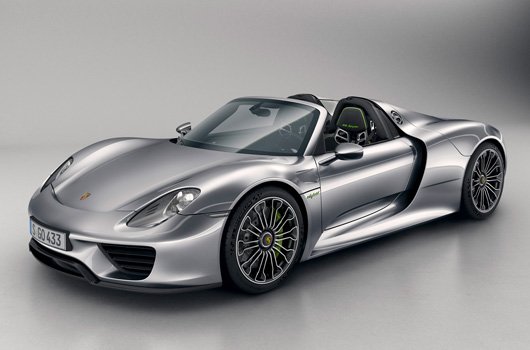
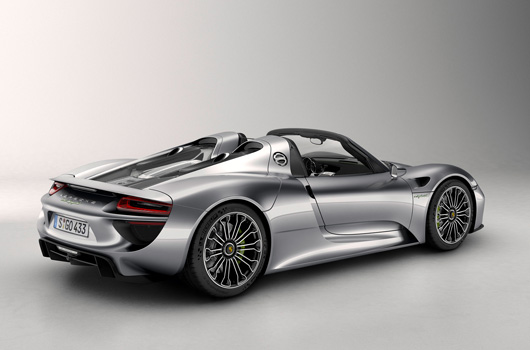
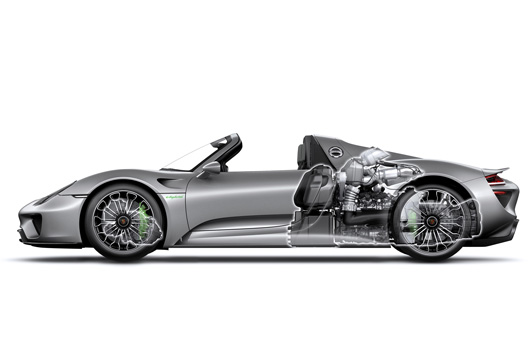
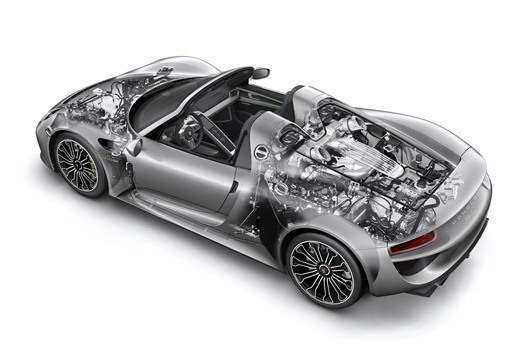
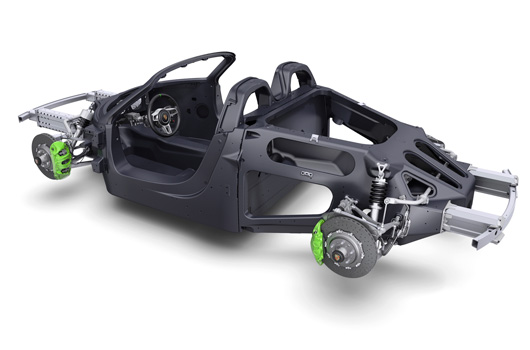
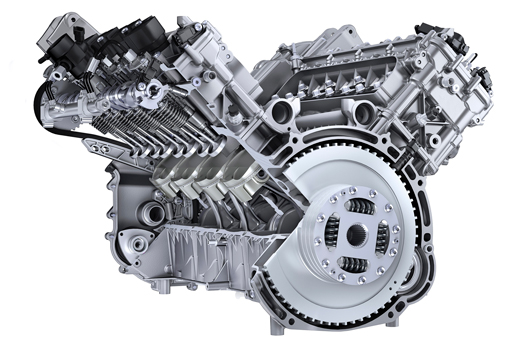
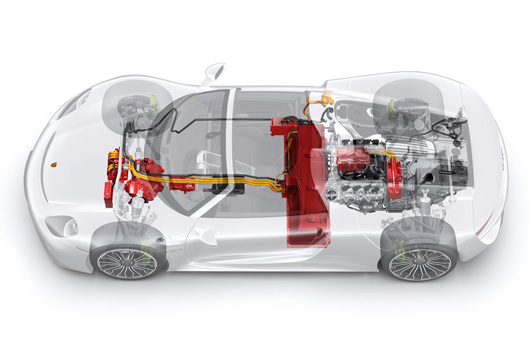
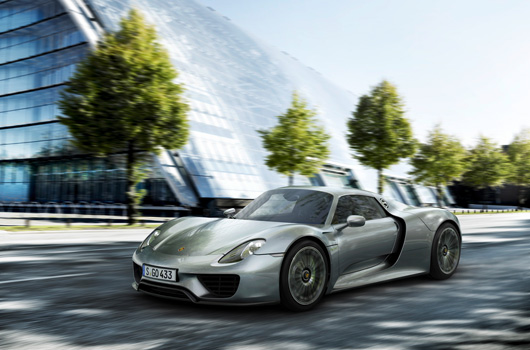
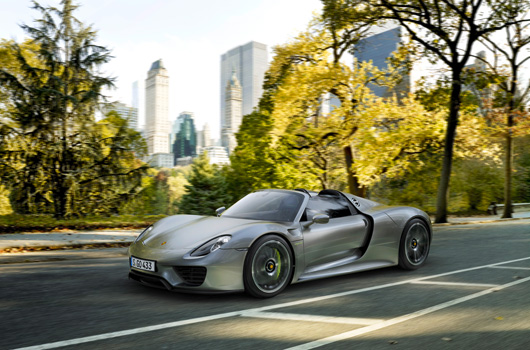
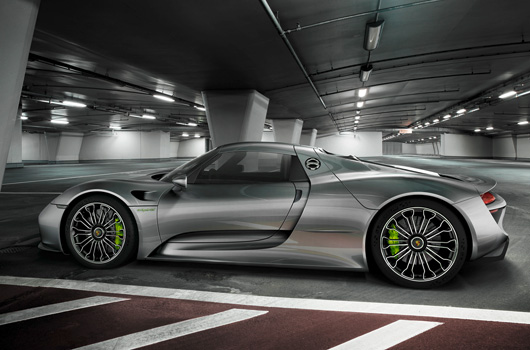
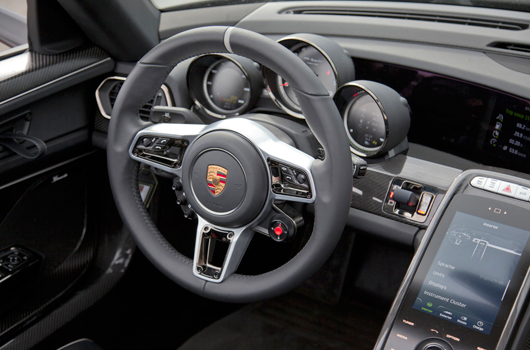
10 replies on “Frankfurt 2013: Porsche 918 Spyder”
Hey, – that time of 7:14 was for the prototype 918. Porsche have just released the time for the production 918 – 6:57!
http://www.motorward.com/2013/09/porsche-918-spyder-nurburgring-lap-record-6-57-minutes/
7:14? No no Lima, try 6:57! First production car under 7 mins. Let’s see what McLaren can do with the P1.
Impressive…. I was looking at the pictures on my screen and said out loud, “now that is sexy”… My wife was about to tell me off, then realised I was talking about a car
[…] to the Nürburgring and created history. The 887hp/652kW petrol electric hybrid has just been officially launched at the Frankfurt Motor Show and Porsche used the occassion to announce the 918′s Nordschleife lap […]
[…] to the Nürburgring and created history. The 887hp/652kW petrol electric hybrid has just been officially launched at the Frankfurt Motor Show and Porsche used the occassion to announce the 918′s Nordschleife lap […]
[…] can see onboard video of Marc Lieb’s full 6:57 lap of the Nürburgring Nordschleife set in a Porsche 918 Spyder ‘Weissach […]
[…] is that Porsche has almost sold all of its 918 Spyder hybrid hypercars. They’re only making 918 of them and the first delivery is expected on the […]
[…] all know the Porsche 918 Spyder lapped the Nürburgring in 6 minutes 57 seconds. An amazing lap, we’re sure you’ll […]
[…] seen of the McLaren P1, with a rumoured 7:04 lap time, and the apparently all-conquering Porsche 918 Spyder. Of course, the 918 grabbed headlines recently when Porsche announced it had broken the 7-minute […]
[…] a reminder that the Porsche 918 has lapped the Ring in a documented 6 minutes 57 seconds. Clearly, McLaren will want to better […]